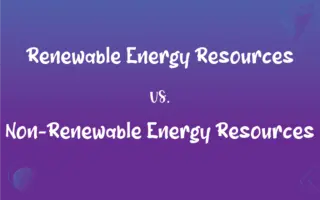UPS vs. Inverter: What's the Difference?
Edited by Aimie Carlson || By Harlon Moss || Updated on October 23, 2023
A UPS provides instant power backup during outages and protects against surges, while an inverter converts DC power to AC power and offers prolonged power backup.

Key Differences
A UPS, or Uninterruptible Power Supply, is an electronic device designed to deliver immediate power during electrical outages. It ensures that devices connected to it, such as computers or data centers, do not experience sudden power loss, preventing potential data corruption or hardware damage. In addition to immediate backup, a UPS is equipped with surge protection capabilities, shielding sensitive electronics from voltage spikes or fluctuations.
On the other hand, an inverter is a device that primarily transforms direct current (DC) into alternating current (AC). This conversion is crucial because most household appliances run on AC power, while batteries, which are often used as backup power sources, store power as DC. An inverter, when coupled with a battery, can offer extended power backup for hours, ensuring continuous operation of connected devices.
While both UPS and inverter provide power backup, their response times and durations vary. A UPS springs into action instantaneously during power disruptions, offering a limited backup time ranging from a few minutes to an hour. This immediate response ensures there's no interruption, especially critical for devices like computers. An inverter, although it may have a slight delay, offers a more extended power backup, making it suitable for prolonged outages.
Another distinguishing factor is their primary use cases. A UPS is typically seen in office environments, safeguarding computers, servers, and other essential equipment. It ensures no data loss occurs during sudden blackouts. Conversely, inverters are more commonly found in households or places needing long-duration backup, such as in areas with frequent power cuts.
To encapsulate, while both UPS and inverter serve the overarching goal of providing power backup, they cater to different needs. A UPS offers immediate short-term backup with surge protection, beneficial for safeguarding sensitive electronics. In contrast, an inverter ensures a longer power backup by converting stored DC power to usable AC power for appliances.
ADVERTISEMENT
Comparison Chart
Primary Function
Immediate power backup with surge protection
Converts DC to AC; provides extended power backup
Response Time
Instantaneous
Slight delay
Backup Duration
Short (minutes to an hour)
Long (hours, depending on the battery)
Primary Use Case
Offices (computers, servers)
Households (appliances)
Protection
Offers surge protection
Generally lacks surge protection
ADVERTISEMENT
UPS and Inverter Definitions
Ups
A tool that shields electronics from voltage spikes.
Thanks to the UPS, the server remained unaffected by the sudden voltage surge.
Inverter
An electronic system offering extended power backup.
During long power outages, the inverter ensures the refrigerator keeps working.
Ups
A backup system offering limited power support.
The UPS gave me enough time to save my work and shut down my computer properly.
Inverter
A solution for transforming battery-stored power into usable energy for appliances.
We relied on the inverter to power our lights and TV when the grid went down.
Ups
A safeguard against potential data loss due to power disruptions.
Companies use UPS systems to prevent data corruption during unexpected power failures.
Inverter
A device converting direct current (DC) to alternating current (AC).
The inverter transformed the battery's DC power to AC, keeping the fan running.
Ups
A device that instantaneously activates upon power loss.
When the lights went out, the UPS immediately powered the essential devices.
Inverter
An alternative power source during lengthy electrical disruptions.
Living in a region with frequent blackouts, an inverter became a household necessity.
Ups
An electronic device that offers immediate power during blackouts.
The UPS ensured the computer didn't shut down abruptly during the power cut.
Inverter
A tool bridging the gap between DC storage and AC-operated devices.
The solar panels stored energy in DC, but the inverter made it usable for household appliances.
Ups
Plural of up
Inverter
One that inverts or produces inversion.
Inverter
A device used to convert direct current into alternating current.
Inverter
An electronic device whose output reverses the sign of its input current or voltage, thereby shifting the phase of alternating current signals by 180 degrees. Also called phase inverter.
Inverter
Something that inverts, or causes inversion.
Inverter
(electrical engineering) A power inverter.
Inverter
An electrical converter that converts direct current into alternating current
FAQs
What's the primary role of an inverter?
An inverter's main function is to convert DC power to AC power.
Does a UPS offer long-duration power backup?
Generally, a UPS provides short-duration backup, from minutes to an hour.
What does UPS stand for?
UPS stands for Uninterruptible Power Supply.
Can an inverter power an entire house?
Depending on its capacity and the battery, an inverter can power selected appliances or an entire house.
Do inverters come with built-in batteries?
Some inverters come with built-in batteries, while others require external batteries.
Is a UPS suitable for home use?
While UPS devices are common in offices, they're also suitable for homes, especially for protecting computers or sensitive electronics.
Should a UPS always be on?
While a UPS can be always on, it's advisable to turn it off when not needed to prolong battery life.
Do inverters produce harmful emissions?
Inverters don't produce harmful emissions; however, the batteries they use might have environmental considerations during disposal.
Can a UPS protect against voltage fluctuations?
Yes, a UPS often has surge protection to guard against voltage spikes.
How long can an inverter provide power?
An inverter's backup duration depends on the battery's capacity and the load connected.
Can inverters charge from the grid?
Yes, most inverters charge batteries using grid power when available.
How is inverter capacity measured?
Inverter capacity is often measured in VA (Volt-Ampere) or watts.
How quickly does a UPS respond to power cuts?
A UPS responds instantaneously during power disruptions.
Can an inverter run air conditioners or heaters?
High-capacity inverters can run air conditioners or heaters, but it significantly shortens backup time.
What happens when a UPS battery dies?
When a UPS battery reaches the end of its life, it needs replacement to ensure effective power backup.
Can a UPS be used as an inverter?
While a UPS can provide power backup like an inverter, its short backup duration makes it less suitable for extended outages.
What's the advantage of a pure sine wave inverter?
Pure sine wave inverters deliver cleaner power, suitable for sensitive electronics, reducing the risk of device malfunction or damage.
What devices are typically connected to a UPS?
Devices like computers, servers, and sensitive electronics are commonly connected to a UPS.
Do UPS devices require maintenance?
Like any electronic equipment, periodic maintenance and battery replacement ensure optimal UPS performance.
Is an inverter silent in operation?
Most modern inverters operate silently, but some older models might produce a humming sound.
About Author
Written by
Harlon MossHarlon is a seasoned quality moderator and accomplished content writer for Difference Wiki. An alumnus of the prestigious University of California, he earned his degree in Computer Science. Leveraging his academic background, Harlon brings a meticulous and informed perspective to his work, ensuring content accuracy and excellence.
Edited by
Aimie CarlsonAimie Carlson, holding a master's degree in English literature, is a fervent English language enthusiast. She lends her writing talents to Difference Wiki, a prominent website that specializes in comparisons, offering readers insightful analyses that both captivate and inform.































































